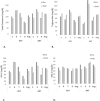Effects of High-Intensity Interval Training Versus Moderate-Intensity Training on Cardiometabolic Health Markers in Individuals With Spinal Cord Injury: A Pilot Study
- PMID: 31548792
- PMCID: PMC6743747
- DOI: 10.1310/sci19-00042
Effects of High-Intensity Interval Training Versus Moderate-Intensity Training on Cardiometabolic Health Markers in Individuals With Spinal Cord Injury: A Pilot Study
Abstract
Background: Recent studies in nondisabled individuals have demonstrated that low-volume high-intensity interval training (HIIT) can improve cardiometabolic health similar to moderate-intensity training (MIT) despite requiring 20% of the overall time commitment. To date, there have been no studies assessing the effects of HIIT for improving cardiometabolic health in individuals with SCI. Objectives: The primary purpose of this pilot study was to compare the effects of 6 weeks of low-volume HIIT vs MIT using arm crank ergometer exercise to improve body composition, cardiovascular fitness, glucose tolerance, blood lipids, and blood pressure in a cohort of individuals with longstanding SCI. Methods: Participants were randomized to 6 weeks of HIIT or MIT arm crank exercise training. Aerobic capacity, muscular strength, blood lipids, glucose tolerance, blood pressure, and body composition were assessed at baseline and 6 weeks post training. Results: Seven individuals (6 male, 1 female; n = 3 in MIT and n = 4 in HIIT; mean age 51.3 ± 10.5 years) with longstanding SCI completed the study. The preliminary findings from this pilot study demonstrated that individuals with SCI randomized to either 6 weeks of HIIT or MIT displayed improvements in (a) insulin sensitivity, (b) cardiovascular fitness, and (c) muscular strength (p < .05). However, MIT led to greater improvements in arm fat percent and chest press strength compared to HIIT (p < .05). Conclusion: No differences between MIT and HIIT were observed. Both conditions led to improvements in insulin sensitivity, aerobic capacity, muscle strength, and blood lipids in individuals with SCI. Future larger cohort studies are needed to determine if the shorter amount of time required from HIIT is preferable to current MIT exercise recommendations.
Keywords: cardiometabolic health; high-intensity interval training; moderate-intensity exercise training; spinal cord injury.
Conflict of interest statement
Conflicts of Interest G. Fisher reports grants from UAB/Lakeshore Research Collaborative during the conduct of the study.
Figures
References
-
- Lee BB, Cripps RA, Fitzharris M, Wing PC. The global map for traumatic spinal cord injury epidemiology: Update 2011, global incidence rate. Spinal Cord. 2014;52(2):110–116. - PubMed
-
- Adriaansen JJ, van Asbeck FW, Lindeman E, van der Woude LH, de Groot S, Post MW. Secondary health conditions in persons with a spinal cord injury for at least 10 years: Design of a comprehensive long-term cross-sectional study. Disabil Rehabil. 2013;35(13):1104–1110. - PubMed
Publication types
MeSH terms
Substances
Grants and funding
LinkOut - more resources
Full Text Sources
Medical


